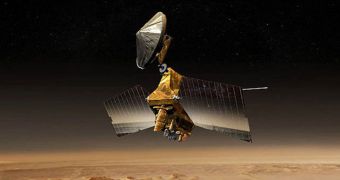The Mars Reconnaissance Orbiter (MRO) has been in a precautionary “safe-mode” since August this year, following a glitch that forced its computers to reboot. This was not the first, and certainly not the most severe such incident to have hit the MRO in the last years. In 2009 alone, three other instances in which the error occurred were recorded. And this is precisely the reason why engineers kept the MRO in safe-mode, in order to cover every possible angle. They have now determined that the spacecraft can handle itself in Martian orbit, and have restarted the probe's computers.
Throughout this week, mission managers will be sending a number of computer commands to the orbiter, which is invaluable at its current location. Engineers now want to conduct a check of all the science instruments aboard the spacecraft. They say that, if everything responds well, then the MRO cameras and detectors could be brought back online by as soon as next week. The MRO mission is managed by scientists at the Jet Propulsion Laboratory (JPL), in Pasadena, California. The NASA laboratory is located at the California Institute of Technology (Caltech).
“The patient is out of danger but more steps have to be taken to get it back on its feet,” JPL MRO Project Manager Jim Erickson said. He added that the upload sequence for the new pieces of software – that are currently being sent to the spacecraft – began on Monday, November 30, and that it would most likely see all the required data making their way to their destination within a few more days. The three other instances when the computers on MRO shut down were recorded on February 23, June 4 and August 6. The fourth and final one, which saw the safe mode being left in place for longer, took place on August 26.
“We hope to gain a better understanding of what is triggering these events and then have the spacecraft safely resume its study of Mars by next week,” Erickson added about the efforts right after the fourth incident took place. He shared that the orbiter was invaluable for Martian science. Since it started surveying the Red Planet, back in 2006, its six science instruments have collected more data about the atmosphere and surface of Mars than all present and past missions combined.

 14 DAY TRIAL //
14 DAY TRIAL //